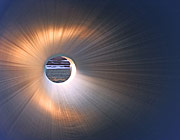The proper performance of a hydraulic system is usually attributed to major components such as the motor, pump and valves. However, there is another unsung component that contributes equally to a system's overall performance: the orifice. In most traditional main hydraulic valves, orifices are built into the casting or dismounting components mold by the component’s constructors. In a cartridge valve manifold (otherwise known as a hydraulic integrated circuit), you start with a blank sheet of paper. Therefore, it is important to know where and when an orifice can change the performance of your system. |
|
The orifice is one of the most versatile components that we can add in our hydraulic circuit. The orifice can be used to limit the amount of oil in one part of our system, to bleed a pressure line to tank, or to transform a nervous and aggressive circuit into an efficient and highly controlled one. Often times the orifice has to simultaneously manage a very small amount of oil, control a dynamic flow rate and dump a system’s compensator. In many applications -- especially for hydrostatic transmissions -- it is important to control the dynamic pressure of the system to avoid pressure spikes and pressure ripple.
The circuit below shows an orifice being used to dampen a load sensing signal to an EPFR (combine pressure control valve and flow regulator). In this circuit, the orifice maintains oil inside the spring chambers of the valves. Without the orifice, any time the spool of your PV (proportional flow control valve) moved, the oil would dump from the spring chamber, creating instability. Fortunately, the orifice restricts the flow path to the EPFR; thereby creating an oil cushion inside the spring chamber of the PV that prevents overshoot and instability.

View/Download Proportional Motor Control Circuit graphic as:
PDF file (90 KB) | DXF file (zipped 90 KB)
Another thing to consider when applying an orifice is that the size of orifice is not always directly related to the size of the valves. Rather, the orifice is sized to the application. While there really is no way to know which size orifice will give you the best performance without performing some tests, one thing to keep in mind is this: the smaller the orifice the more susceptible it will be to contamination.
In a system where the flow rate needs to be decreased for the sake of dumping oil from a compensator in a controlled manner (think a flow rate of 5 lpm to 1.5 lpm) you might need an orifice disc smaller than 0.5 mm. To reduce your contamination risks you may want to install two or more orifices in series. By using two larger diameter orifices in series you can achieve the same equivalent restriction as a single, smaller diameter orifice.

Quick calculation tool in MS Excel format:
XLS file (zipped 90 KB)

Damiano Roberti is an application engineer for HydraForce Hydraulics Ltd., representing the southeast region of Europe. Damiano resides in Modena, Italy. Contact Damiano





